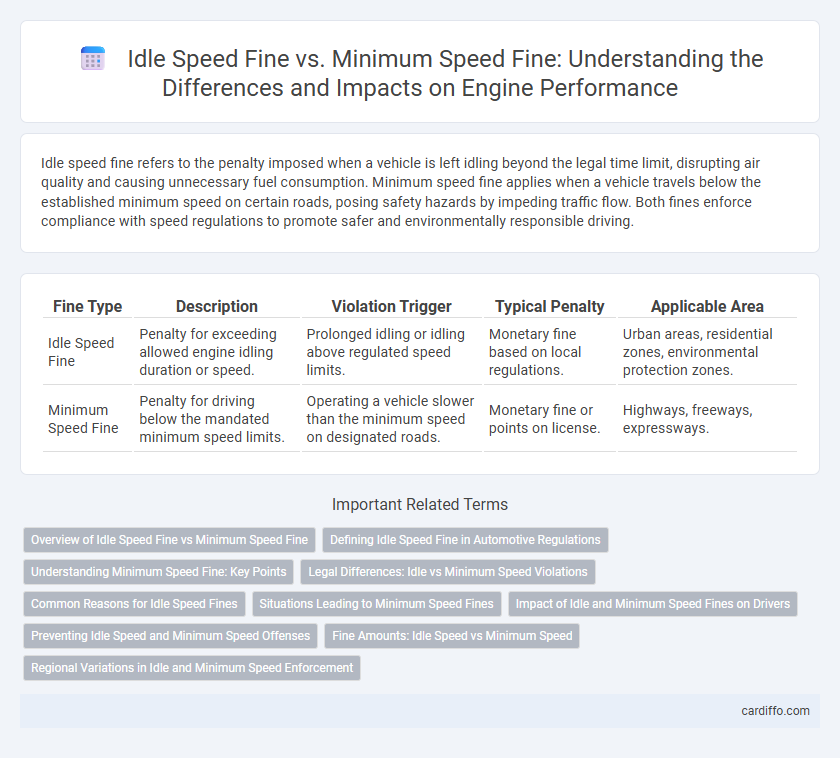Idle speed fine refers to the penalty imposed when a vehicle is left idling beyond the legal time limit, disrupting air quality and causing unnecessary fuel consumption. Minimum speed fine applies when a vehicle travels below the established minimum speed on certain roads, posing safety hazards by impeding traffic flow. Both fines enforce compliance with speed regulations to promote safer and environmentally responsible driving.
Table of Comparison
| Fine Type | Description | Violation Trigger | Typical Penalty | Applicable Area |
|---|---|---|---|---|
| Idle Speed Fine | Penalty for exceeding allowed engine idling duration or speed. | Prolonged idling or idling above regulated speed limits. | Monetary fine based on local regulations. | Urban areas, residential zones, environmental protection zones. |
| Minimum Speed Fine | Penalty for driving below the mandated minimum speed limits. | Operating a vehicle slower than the minimum speed on designated roads. | Monetary fine or points on license. | Highways, freeways, expressways. |
Overview of Idle Speed Fine vs Minimum Speed Fine
Idle speed fines typically apply when a vehicle's engine remains running while stationary, violating local anti-idling regulations designed to reduce pollution and noise. Minimum speed fines occur when a vehicle travels below the legally mandated speed limit, potentially causing traffic disruption and safety hazards. Both fines aim to enforce traffic laws but target different driving behaviors related to engine idling and vehicle speed.
Defining Idle Speed Fine in Automotive Regulations
Idle speed fine in automotive regulations refers to penalties imposed when a vehicle's engine idle speed exceeds or falls below specified limits set to reduce emissions and conserve fuel. These limits ensure the engine runs at a controlled RPM when the vehicle is stationary, preventing unnecessary environmental impact. Distinguishing idle speed fines from minimum speed fines is crucial, as minimum speed fines target moving vehicle speed compliance rather than engine idle conditions.
Understanding Minimum Speed Fine: Key Points
Minimum speed fine is a penalty imposed when a vehicle fails to maintain a mandated minimum speed on specific roadways, ensuring traffic flow and safety. This fine differs from an idle speed fine, which targets vehicles consuming fuel inefficiently while stationary or moving very slowly. Understanding minimum speed fines helps drivers avoid violations that disrupt traffic and potentially cause accidents.
Legal Differences: Idle vs Minimum Speed Violations
Idle speed fines are typically issued when a vehicle remains stationary with the engine running beyond a legally allowed time limit, aiming to reduce emissions and noise pollution. Minimum speed fines occur when a driver fails to maintain a legally required speed on specific roadways, potentially disrupting traffic flow and causing safety hazards. Legally, idle speed violations focus on environmental regulations, while minimum speed violations emphasize traffic safety and smooth vehicular movement.
Common Reasons for Idle Speed Fines
Common reasons for idle speed fines include excessive engine idling beyond regulated limits, often due to extended waiting times or improper vehicle operation during stops. Unnecessary engine running in restricted zones contributes significantly to these fines, as it leads to increased emissions and noise pollution. Enforcement agencies monitor idle speeds closely to ensure compliance with environmental standards and reduce fuel wastage.
Situations Leading to Minimum Speed Fines
Situations leading to minimum speed fines often include driving significantly below the posted speed limit on highways or major roads, causing traffic disruptions and potential hazards. Common scenarios involve cautious driving in low-traffic areas, heavy vehicle operation restrictions, or poor road conditions prompting drivers to reduce speed excessively. Law enforcement targets these conditions to maintain efficient traffic flow and prevent accidents resulting from unusually slow driving.
Impact of Idle and Minimum Speed Fines on Drivers
Idle speed fines penalize drivers for excessive engine idling, increasing fuel consumption and emissions, which directly impacts operational costs and environmental compliance. Minimum speed fines enforce traffic flow regulations by discouraging drivers from moving below a set threshold, reducing congestion and enhancing road safety but potentially causing fines that affect driver's financial management. Both fines influence driver behavior by promoting efficient vehicle operation and adherence to traffic laws, ultimately impacting driver expenses and regulatory risk.
Preventing Idle Speed and Minimum Speed Offenses
Preventing idle speed and minimum speed offenses requires precise vehicle speed management to avoid fines and enhance road safety. Maintaining engine RPM within manufacturer-recommended idle speed limits prevents excessive emissions and mechanical wear, while adhering to minimum speed regulations ensures smooth traffic flow and compliance with local laws. Regular engine tuning and speed monitoring technology help drivers stay within legal boundaries, minimizing the risk of fines and promoting efficient vehicle operation.
Fine Amounts: Idle Speed vs Minimum Speed
Fine amounts for idle speed violations typically range from $50 to $200, reflecting minor infractions related to engine idling times. Minimum speed fines are generally higher, often between $100 and $400, due to the increased risk posed by driving below the minimum speed limit on highways or expressways. Enforcement agencies prioritize these fines to discourage unsafe driving behaviors that affect traffic flow and safety.
Regional Variations in Idle and Minimum Speed Enforcement
Regional variations in idle speed fines and minimum speed fines reflect differing regulatory priorities and environmental concerns across jurisdictions. Some areas impose stricter idle speed fines to reduce emissions in urban zones, while others emphasize minimum speed enforcement on highways to maintain traffic flow and safety. These discrepancies influence driver behavior and compliance, highlighting the need for localized traffic policies tailored to specific regional conditions.
Idle speed fine vs Minimum speed fine Infographic

 cardiffo.com
cardiffo.com